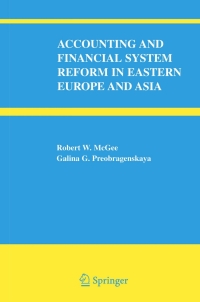The Nolan Company is a publicly traded corporation that produces different types of digital control systems. My name is John Martin and I have worked for this company for the last ten years in the controller's office. I was both an accounting and finance major in university. The company currently produces 250 products and does not anticipate any new products coming out over the next three years. I have previously mentioned to my superiors that it is not appropriate for our firm to use a traditional accounting system (where overhead costs are allocated across products at a rate of 325% of direct labor costs) when different products require different amounts of indirect resources. For example, under the traditional system all costs associated with testing of products for quality assurance purposes are part of overhead costs and therefore allocated across products based on direct labor costs. Yet, some of our products require as much as 5 hours of testing whereas some products require less than 1 minute of testing with no connection to direct labor costs. Given that traditional costing systems result in significant cost distortions when determining products costs and given that the firm now has revenues of over $250,000,000 a year, Nolan has decided to adopt activity-based costing over the next year or two 1 Nolan's management has hired J.D. Consulting to help us implement activity-based costing. I will be acting as the liaison between our firm and J.D. As part of the initial implementation phase, I have asked J.D. to derive the costs and net operating incomes associated with two of our products for this past year, plume and falone, so that these costs and net operating incomes could be compared with the costs and net operating incomes under our current traditional accounting system for this past year. I picked these products since Nolan's management believe they have very different demands on indirect resources. Further, plume is sold in large quantities whereas falone is sold in small quantities and traditional accounting systems can cause large cost distortions in different directions for products sold in large and small quantities. Current information from our existing system on a per unit basis is shown in Exhibit I. Exhibit 1 plume falone Direct material $7 $7 Direct labor hours Direct labor cost per hour S10 SIO Sales price per unit 38 My staff has identified for Nolan five cost pools. Information on those cost pools and the related allocation bases are provided in Exhibit 2. Exhibit 2 Value of Total Costs Allocation Base Allocation Base Equipment setups $12,500,000 number of setups 50,000 Purchase orders $8,000,000 number of purchase orders 160,000 Machining $12,000,000 number of machine hours 1,000,000 Testing $3,600,000 number of testing hours 600,000 Packaging $4,600,000 number of containers 1,000,000 0.5 0.5 $32 C n Packaging $4,600,000 number of containers 1,000,000 Although fixed costs are lumped in with variable costs across the five different cost pools, I am aware that machining related costs consists almost exclusively of depreciation costs. Hence, with respect to all questions asked in the case, machining costs will be treated as entirely fixed with respect to machine hours. Each machine is used in the production of multiple product lines. The resale value of machines is only affected by the passage of time and not by how much they are used in a given year In all questions asked in this case, the firm will assume that costs associated with equipment setups, purchase orders, testing, and packaging are variable with respect to their respective allocation bases. Currently, we believe our assumptions on cost behavior patterns are quite reasonable All products are produced in batches, where the size of a batch differs across products. For example, if we produce 80 units of a product in batch sizes of 40, then the product will be produced in two batches. An equipment setup must be performed before producing each batch of a product . Hence, in the example above, two equipment setups would be performed. Units of product are packaged in containers and sent to distributors. Production volumes are set equal to sales volumes since the company only produces products that they have orders for. Consequently, the firm never has a beginning work in process inventory, or a beginning finished goods inventory. (Hence, the firm never has ending inventories.) Further information on our two products is provided in Exhibit 3 Exhibit 3 plume falone annual sales and production in units 240,000 4.800 number of units per batch 150 number of purchase orders 80 number of machine hours per unit testing hours 12,000 8,400 number of containers 1,400 600 I 40 450 0.40 0.8 ERALD 5. (10 Points) Question 5 is independent of question 4. Next year, because of an expected increase in product demand, machine hours are expected to increase from 1,000,000 to 1,200,000. The company will not need any new machinery since the current machinery is highly underutilized. Also, the number of purchase orders will increase from 160,000 to 200,000. Assume that these new levels of operations are within the firm's relevant range. Calculate what the activity rate for the cost pool of machining would be next year if it can be calculated. Also, calculate what the activity rate for the cost pool of purchase order would be next year if it can be calculated. If one or both rates cannot be calculated, then explain in words why the calculations cannot be determined in the absence of more information. Excluding any quantitative analysis, your explanation should not be more than 1/3 page double spaced with 12 font









